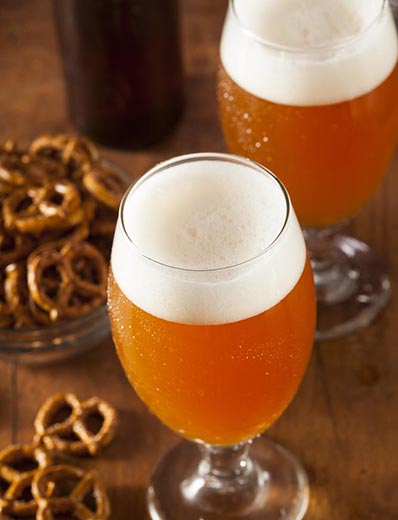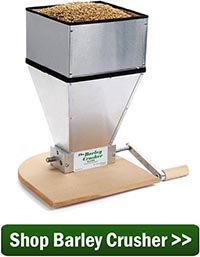 After developing a recipe and experimented with brewing water adjustments for this beer, the actual brewing of the Ithaca Beer Co. Flower Power clone beer recipe was put on hold for a couple weeks while I was out of town. I finally got around to brewing the IPA last weekend and boy am I excited about this beer! Brew day didn’t exactly go off without a hitch, but there weren’t any major issues that should cause major problems down the line. Here’s how brew day went last weekend.
After developing a recipe and experimented with brewing water adjustments for this beer, the actual brewing of the Ithaca Beer Co. Flower Power clone beer recipe was put on hold for a couple weeks while I was out of town. I finally got around to brewing the IPA last weekend and boy am I excited about this beer! Brew day didn’t exactly go off without a hitch, but there weren’t any major issues that should cause major problems down the line. Here’s how brew day went last weekend.
Preparing the Yeast Starter
The night before brewing I made a yeast starter with light DME and one pack of California ale yeast. I don’t have a stir plate or flask yet (they’re on the list!), so I just used a growler and gave the starter a swirl every few hours or so.
The Set Up
I usually try to get all my ingredients and gear together before I actually start brewing. This helps eliminate the multitasking that can often result in a mistake.
First I assembled the ingredients: malt, hops, yeast starter, and water amendments. Then I get all the equipment set up, plus a stack of towels at the ready. I’ll usually turn on some music and have a snack on hand just in case. At least a few days in advance, I’ll check the propane tank to make sure there’s enough fuel for the brew. Did you know you can weigh the tank to estimate how much fuel you have left? I’ll share how to do that in a separate post.
Clean and Sanitize
The next step before brewing the Flower Power clone recipe– and in many ways the most important – is to clean and sanitize the brewing equipment. I won’t go over this in detail, but if you need a refresher you can check out this post for tips.
The Mash
I mashed my crushed grains in about 4.75 gallons of water. One thing I’ve been trying to dial in over the past few brews in my strike temperature – that is, the temperature of the water before it goes into the mash. Since the grain and the mash tun are often room temperature, you have to compensate by adding water that’s at least 10-15˚F hotter than your target mash temperature. Given that things are even colder in the winter, I aimed high. With a strike temperature of 180˚F, I was able to get the mash temperature right where I wanted it, in the mid-150s. You can use a calculator such as this one to estimate your strike temperature.
Here’s where I ran into a little problem – despite my efforts to get organized before brewing, after 60 minutes I realized I’d forgotten to add the honey malt! Doh! Luckily it’s not a big mistake. The honey malt is in the clone recipe mostly for flavor and color, and in theory the sugars should only take 30 minutes to convert. So I just mixed in the honey malt and added 30 minutes to the mash time. With the extra time added to the mash, I probably ended up with even better efficiency than I would have otherwise!
The Sparge 
I find I’m consistently low on the amount of sparge water I need. My calculations said 4-4.5 gallons would do the trick, but between grain absorption and volume loss in the mash tun, I was about a gallon short of my pre-boil volume. I just quickly heated up another gallon of water and made a note to adjust my calculations for next time.
At the end of the sparge I found I had six gallons of wort with a preboil gravity of 1.068 – right on target!
The Boil
I think of the boil as the start of the home stretch. All it takes is watching the clock to make sure the hops get in on time. The four hop additions for this Flower Power clone beer recipe smelled amazing – Simcoe at :60, Chinook at :20, Citra at :10, and Ahtanum and Centennial at :0. And we haven’t even touched the dry hops yet!
My post-boil gravity was 1.075 – just a point shy of the estimated OG – but well within the margin of error. This beer should easily surpass 7% ABV.
The Chill & the Pitch
The colder ground water temperatures this time of year really help with cooling the wort quickly. My immersion wort chiller got the wort to pitching temperature in about 20 minutes. I pitched the yeast starter and now the beer is fermenting happily in the fermentation chamber!
Stay tuned to see how this Flower Power clone beer recipe turns out!
—————————————————————–
Review the whole Flower Power clone brewing process below:
- Part 1: Developing a Recipe
- Part 2: Brewing Water Adjustments
- Part 3: Brew Day
- Part 4: Primary Fermentation Mishaps
- Part 5: Bottling & Kegging
- Part 6: A Conditioning Taste Test
- Part 7: Final Side-by-Side and Recipe Edits
—————————————————————–
David Ackley is a beer writer, homebrewer, and self-described “craft beer crusader.” He holds a General Certificate in Brewing from the Institute of Brewing and Distilling and is founder of the Local Beer Blog.
